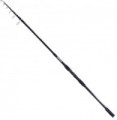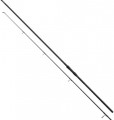Design
The general design of the rod. Most often it is folding —
plug -in or
telescopic — however, there are also
one-piece models. Here are the main features of each option:
— Plug. Such rods consist of several sections, which are completely disconnected in the stowed state, and before use they are connected to each other using bushings. On the one hand, this creates certain inconveniences: for example, for reliable transportation, it is necessary to place the fishing rod in a case or otherwise securely connect the components of the rod. Yes, and the process of unfolding / folding can be quite troublesome. At the same time, this design is considered optimal for rods designed for maximum accuracy and/or casting distance — for example, spinning, match and feeder rods (see "Rod Type"). Almost all such models are plug-in. Also note that you should not confuse the plug as a type of rod (see ibid) with this design option: plug-type models can formally be telescopic (this means that part of the rod looks like a “telescope”, see “Rod Type” for more details) )..
— Telescopic. She's "retractable". A design in which the sections have different thicknesses and are inserted one into the other in the folded position, and when unfolded they are alternately extended. Such a scheme provides maximum convenience during transportation — the rod is a “case itself” and does not requ
...ire additional cases or ties, unlike the plug-in design. At the same time, the "telescope" significantly reduces the accuracy of casting, and therefore it is used mainly where this parameter is not of decisive importance — in particular, in Bologna and flywheel models (see "Rod type").
— Whole. Solid rods are stronger and more reliable than composite rods, but they have one serious drawback: they cannot be folded for transportation and storage. Therefore, such a design is used relatively rarely — in particular, in individual spinning models of relatively short length, as well as in winter rods, which, in principle, do not need to be made long.Sections
The number of sections provided in the design of the folding rod (see "Design"). Of two rods of the same length, a model with more sections will have a smaller length of each individual section and, accordingly, will be more compact and easier to transport. On the other hand, numerous sections adversely affects the overall strength of the structure. Therefore, when choosing, it is desirable to decide what is more important for you — ease of transportation or high strength.
Working length
The length of the rod in the unfolded (working) position. For different types of fishing, different lengths are considered optimal; see "Rod Type" for more on this. If the type of rod you need has numerous length variations, when choosing, you should take into account the conditions in which you have to fish. On the one hand, longer models usually have a greater casting distance (this is especially true for float fishing); on the other hand, for limited conditions (for example, with dense vegetation on the shore or when fishing from a boat), it may make sense to take a shorter rod.
Folded length
The length of the rod when folded. This parameter primarily affects the convenience of transportation: the shorter the folded rod, the easier it is to carry / transport.
Handle material
—
Cork. Handles made of natural cork. This material has many advantages: due to its porosity, it is light and poorly conducts heat (“warms the hand” in the cold), at the same time it does not get wet, and cork handles look quite elegant. The main disadvantage is the relatively high cost, as a result of which cork handles are found mainly in rods of the middle and higher price range (although there are also inexpensive models with such handles).
—
Foam rubber (EVA). Handles made of finely porous ethylene vinyl acetate, a synthetic material. Initially, EVA was used in rods designed for sea fishing — this material is much more resistant to salt water, ultraviolet radiation and other negative influences than cork. However, now it is very common in all types of fishing rods. The advantages of EVA, in addition to the above, are low cost, as well as a variety of designs — unlike cork, this material can be given almost any colour. On the other hand, EVA is significantly heavier, which can be critical for professional anglers who balance their rods to the nearest gram (especially when using ultralight rods). Therefore, such pens are mainly characteristic of inexpensive amateur models.
— Cork / foam rubber. Combined handles, combining both of the above materials in the design. Thus, the advantages of cork and foam rubber are combined, and the disadvantages are partially compensated (for more detai
...ls about the advantages and disadvantages, see above). At the same time, this option is quite rare, because. for a number of reasons, it is still considered more justified to use one specific material.
— Styrofoam. Styrofoam handles — "foamed" plastic (usually based on polystyrene). It consists of individual microscopic cells filled with gas, while the volume of gas can be up to 98% of the volume of the entire material. This determined the main properties of the foam: it is very light, resistant to moisture, in addition, it poorly conducts heat and does not “cool” the hands. Due to the latter, foam handles are well suited, in particular, to winter rods (see "Rod type"). On the other hand, the strength and durability of foam plastic is somewhat lower than that of cork and foam rubber.
— Plastic. Classic plastic is inexpensive, and it is often noticeably stronger than the cork, foam rubber or foam plastic described above. On the other hand, this material is noticeably heavier and has a relatively high thermal conductivity (that is, it can cool hands in cool weather). Thus, plastic handles are mainly used in ultra-compact winter rods. The weight of such tackle is small even taking into account the handle, it does not need an perfect balance, the high strength of the handle is important for technical reasons, and fishing is still supposed to be in warm gloves that reliably isolate hands from the cold.
— Carbon. A variant found in rods made of the same material (see above). The handle in such models is usually a thickening of a special shape on the body. This design allows you to reduce weight and provide maximum responsiveness of the rod, however, it is not cheap. As a result, it is found predominantly among high-end casting models (see "Rod Type"). Like the rods themselves, carbon handles are very resistant to bending, but are sensitive to strong impacts (may crack).
